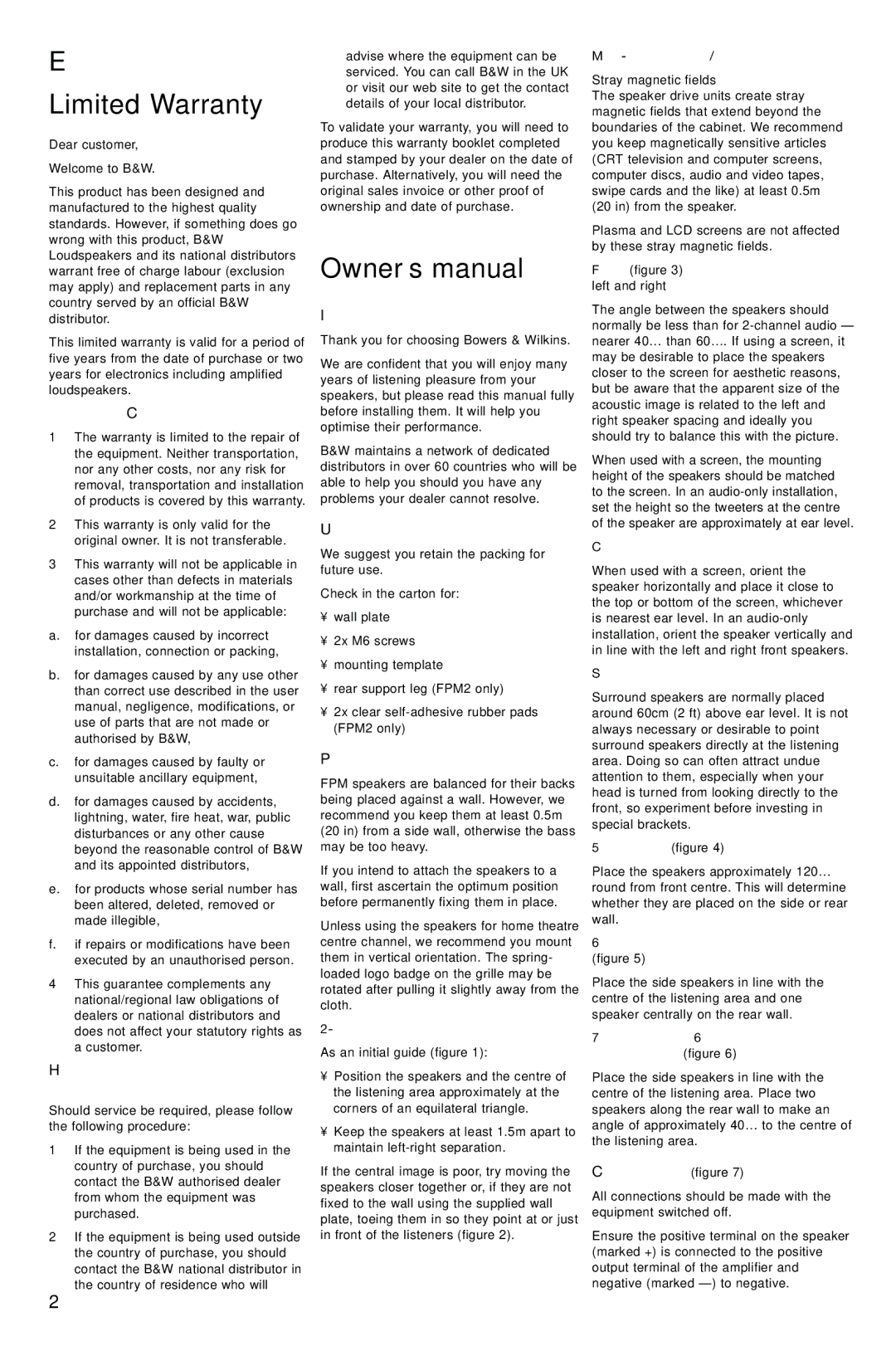English
Limited Warranty
Dear customer,
Welcome to B&W.
This product has been designed and manufactured to the highest quality standards. However, if something does go wrong with this product, B&W Loudspeakers and its national distributors warrant free of charge labour (exclusion may apply) and replacement parts in any country served by an official B&W distributor.
This limited warranty is valid for a period of five years from the date of purchase or two years for electronics including amplified loudspeakers.
Terms and Conditions
1The warranty is limited to the repair of the equipment. Neither transportation, nor any other costs, nor any risk for removal, transportation and installation of products is covered by this warranty.
2This warranty is only valid for the original owner. It is not transferable.
3This warranty will not be applicable in cases other than defects in materials and/or workmanship at the time of purchase and will not be applicable:
a.for damages caused by incorrect installation, connection or packing,
b.for damages caused by any use other than correct use described in the user manual, negligence, modifications, or use of parts that are not made or authorised by B&W,
c.for damages caused by faulty or unsuitable ancillary equipment,
d.for damages caused by accidents, lightning, water, fire heat, war, public disturbances or any other cause beyond the reasonable control of B&W and its appointed distributors,
e.for products whose serial number has been altered, deleted, removed or made illegible,
f.if repairs or modifications have been executed by an unauthorised person.
4This guarantee complements any national/regional law obligations of dealers or national distributors and does not affect your statutory rights as a customer.
How to claim repairs under warranty
Should service be required, please follow the following procedure:
1If the equipment is being used in the country of purchase, you should contact the B&W authorised dealer from whom the equipment was purchased.
2If the equipment is being used outside the country of purchase, you should contact the B&W national distributor in the country of residence who will
advise where the equipment can be serviced. You can call B&W in the UK or visit our web site to get the contact details of your local distributor.
To validate your warranty, you will need to produce this warranty booklet completed and stamped by your dealer on the date of purchase. Alternatively, you will need the original sales invoice or other proof of ownership and date of purchase.
Owner’s manual
Introduction
Thank you for choosing Bowers & Wilkins.
We are confident that you will enjoy many years of listening pleasure from your speakers, but please read this manual fully before installing them. It will help you optimise their performance.
B&W maintains a network of dedicated distributors in over 60 countries who will be able to help you should you have any problems your dealer cannot resolve.
Unpacking
We suggest you retain the packing for future use.
Check in the carton for:
•wall plate
•2x M6 screws
•mounting template
•rear support leg (FPM2 only)
•2x clear
Positioning
FPM speakers are balanced for their backs being placed against a wall. However, we recommend you keep them at least 0.5m (20 in) from a side wall, otherwise the bass may be too heavy.
If you intend to attach the speakers to a wall, first ascertain the optimum position before permanently fixing them in place.
Unless using the speakers for home theatre centre channel, we recommend you mount them in vertical orientation. The spring- loaded logo badge on the grille may be rotated after pulling it slightly away from the cloth.
2-channel audio
As an initial guide (figure 1):
•Position the speakers and the centre of the listening area approximately at the corners of an equilateral triangle.
•Keep the speakers at least 1.5m apart to maintain
If the central image is poor, try moving the speakers closer together or, if they are not fixed to the wall using the supplied wall plate, toeing them in so they point at or just in front of the listeners (figure 2).
Multi-channel audio/video
Stray magnetic fields
The speaker drive units create stray magnetic fields that extend beyond the boundaries of the cabinet. We recommend you keep magnetically sensitive articles (CRT television and computer screens, computer discs, audio and video tapes, swipe cards and the like) at least 0.5m (20 in) from the speaker.
Plasma and LCD screens are not affected by these stray magnetic fields.
Front (figure 3) left and right
The angle between the speakers should normally be less than for
When used with a screen, the mounting height of the speakers should be matched to the screen. In an
Centre channel
When used with a screen, orient the speaker horizontally and place it close to the top or bottom of the screen, whichever is nearest ear level. In an
Surround
Surround speakers are normally placed around 60cm (2 ft) above ear level. It is not always necessary or desirable to point surround speakers directly at the listening area. Doing so can often attract undue attention to them, especially when your head is turned from looking directly to the front, so experiment before investing in special brackets.
5.1systems (figure 4)
Place the speakers approximately 120º round from front centre. This will determine whether they are placed on the side or rear wall.
6.1systems with one rear speaker (figure 5)
Place the side speakers in line with the centre of the listening area and one speaker centrally on the rear wall.
7.1systems and 6.1 systems with two rear speakers (figure 6)
Place the side speakers in line with the centre of the listening area. Place two speakers along the rear wall to make an angle of approximately 40º to the centre of the listening area.
Connections (figure 7)
All connections should be made with the equipment switched off.
Ensure the positive terminal on the speaker (marked +) is connected to the positive output terminal of the amplifier and negative (marked
2
